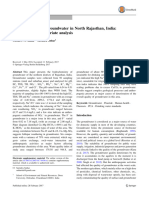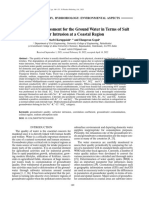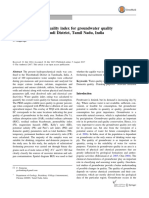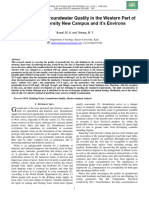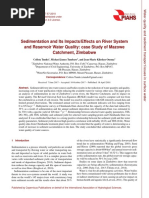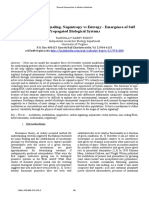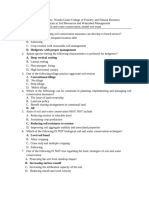0 ratings0% found this document useful (0 votes)
63 viewsTMP 2 F56
E-offprint is for personal use only and shall not be self-archived in electronic repositories. Groundwater samples from hand pumps and tube wells of 16 stations were analyzed during postmonsoon and pre-monsoonal (2008). Results shows higher concentration of total dissolved solids, electrical conductivity, sodium, chloride, and sulfate which indicate signs of deterioration.
Uploaded by
FrontiersCopyright
© © All Rights Reserved
Available Formats
Download as PDF, TXT or read online on Scribd
0 ratings0% found this document useful (0 votes)
63 viewsTMP 2 F56
E-offprint is for personal use only and shall not be self-archived in electronic repositories. Groundwater samples from hand pumps and tube wells of 16 stations were analyzed during postmonsoon and pre-monsoonal (2008). Results shows higher concentration of total dissolved solids, electrical conductivity, sodium, chloride, and sulfate which indicate signs of deterioration.
Uploaded by
FrontiersCopyright
© © All Rights Reserved
Available Formats
Download as PDF, TXT or read online on Scribd
You are on page 1/ 10
1 3
Arabian Journal of Geosciences
ISSN 1866-7511
Volume 6
Number 1
Arab J Geosci (2013) 6:101-108
DOI 10.1007/s12517-011-0327-2
Evaluation of hydrogeochemical
parameters and quality assessment of the
groundwater in Kottur blocks, Tiruvarur
district, Tamilnadu, India
Thirunavukkarasu Ramkumar,
Senapathi Venkatramanan,
Irudhayanathan Anithamary & Sheik
Mohamed Syed Ibrahim
1 3
Your article is protected by copyright and all
rights are held exclusively by Saudi Society
for Geosciences. This e-offprint is for personal
use only and shall not be self-archived in
electronic repositories. If you wish to self-
archive your work, please use the accepted
authors version for posting to your own
website or your institutions repository. You
may further deposit the accepted authors
version on a funders repository at a funders
request, provided it is not made publicly
available until 12 months after publication.
ORIGINAL PAPER
Evaluation of hydrogeochemical parameters and quality
assessment of the groundwater in Kottur blocks, Tiruvarur
district, Tamilnadu, India
Thirunavukkarasu Ramkumar & Senapathi Venkatramanan &
Irudhayanathan Anithamary & Sheik Mohamed Syed Ibrahim
Received: 8 October 2010 / Accepted: 24 March 2011 / Published online: 9 April 2011
# Saudi Society for Geosciences 2011
Abstract A study was conducted to evaluate the water
quality of Kottur block, Thiruvarur district, Tamilnadu.
Groundwater samples from hand pumps and tube wells of
16 stations were analyzed during postmonsoon and pre-
monsoon (2008) with the help of standard methods of
APHA (1995). Dominance of cations are in the following
order Na>Ca>K>Mg and Cl>SO
4
>HCO
3
>NO
3
by anions
in both the seasons. The analytical results shows higher
concentration of total dissolved solids, electrical conduc-
tivity, sodium, chloride, and sulfate which indicate signs of
deterioration but values of pH, calcium, magnesium, and
nitrate are within permissible limit as per World Health
Organization standards. From the Piper trilinear diagram, it
is observed that the majority of groundwater samples are
Na-Cl and Ca-Mg-SO
4
facies clearly indicates seawater
incursion. In Wilcox diagram, most of the samples fall in
low to very high sodium hazard and low to very high
salinity hazard indicates moderately suitable for agricultural
activities. Kellys ratio and magnesium ratio indicates most
of the samples fall in suitable for irrigation purpose.
Keywords Groundwater chemistry
.
Piper trilinear
diagram
.
Wilcox diagram
.
Kelly ratio
.
Magnesium ratio
Introduction
Water is very vital for nature and can be a limiting resource
to men and other living beings. Without a well-functioning
water supply, it is difficult to imagine productive human
activity be it agriculture or livestock. The quality of water is
of almost the same importance to quantity in any water
supply planning. Water quality is influenced by natural and
anthropogenic effects including local climate, geology, and
irrigation practices. The chemical character of any ground-
water determines its quality and utilization. The quality is a
function of the physical, chemical, and biological parame-
ters, and could be subjective since it depends on a particular
intended use. Various workers in our country have carried
out extensive studies on water quality. In addition to the
rising demands of potable water in households, the shallow
aquifers have been the source of water for most irrigation
schemes in Keta and surrounding areas. Whereas irrigation
activities are very much encouraged as poverty reduction
strategies, the use of high salinity water has the tendency to
reduce soil and crop productivity in an area over time by
destroying soil permeability and reducing the osmotic
potential of crops. In light of this, one of the management
strategies for groundwater resources especially in the
coastal belt is to ensure that groundwater extraction does
not lead to the intrusion of saline seawater into the aquifers.
However, due to the relatively low elevations in the area
and the lack of strict regulation, groundwater salinization
continues to be a problem in some of the coastal areas
(Bannerman 1994; Jorgensen and Banoeng-Yakubo 2001;
Helstrup et al. 2007). On the other hand, this resource is the
only source of water for agricultural activities in view of the
erratic nature of rainfalls in recent times. The high salinities
of groundwater from some of the wells in the area and the
heavy reliance of the communities on groundwater for
T. Ramkumar
Department of Earth Sciences, Annamalai University,
Chidambaram, Tamilnadu, India
e-mail: tratrj@gmail.com
S. Venkatramanan (*)
:
I. Anithamary
:
S. M. S. Ibrahim
Research scholar, Department of Earth Sciences,
Annamalai University,
Chidambaram, Tamilnadu, India
e-mail: venkatramanansenapathi@gmail.com
Arab J Geosci (2013) 6:101108
DOI 10.1007/s12517-011-0327-2
Author's personal copy
irrigation necessitate an overall assessment of the quality of
the resource in the area for irrigation purposes (Yidana et al.
2010; Ramkumar et al. 2010; Venkatramanan et al. 2009).
Laluraj et al. (2005) have studied groundwater chemistry of
shallow aquifers in the coastal zones of Cochin and
concluded that groundwater present in the shallow aquifers
of some of the stations were poor in quality and beyond
potable limit as per the standard set by World Health
Organization and Bureau of Indian Standards. Rapid
increase in urbanization and industrialization leads into
deterioration in groundwater quality.
In coastal environments, the influence of saltwater intru-
sion is often significant. The specific objectives of this study
are (1) the preliminary investigation and interpretation of the
groundwater quality of Kottur block (2) find out the suitability
of groundwater for irrigation and drinking purposes. This
insight hopefully would aid in ensuring better water resource
management in Kottur and its immediate environs. (3) This
study proposes using spatial mapping to identify areas that are
likely to be contaminated, and to use spatial variance of
collected data from the field to identify areas that are not
covered and lack information. With the help of GIS tools, this
approach has been used to assess the sodium and chloride
variation in Kottur block, India.
Description of the study area
The study area, Kottur block is situated in Tiruvarur district
of Tamilnadu (Fig. 1). The study area lies between latitude
10 4145 North and longitude 79 2500 East in the
survey of India toposheets number 58 N/7, N/10, and N/11.
The area receives an annual average rainfall of
1,327.11 mm. The maximum and minimum temperature
ranges between 28C and 34C in the months of January to
May, respectively.
Materials and methods
Groundwater samples from different hand pumps and tube
wells of 16 sampling points were analyzed during post and
premonsoon seasons during 2008. Samples were collected in
good quality polyethylene bottles of 1-l capacity. Sampling was
carried out without adding any preservatives in rinsed bottles
directly for avoiding any contamination and brought to the
laboratory. Monitoring was done during post and premonsoon
(February 2008September 2006). Only high pure (Analytical
IR Grade) chemicals and double-distilled water was used for
preparing solutions for analysis. Physical parameters like pH
Fig. 1 Study area and sampling location
102 Arab J Geosci (2013) 6:101108
Author's personal copy
(eco-tester pH 1) and total dissolved solids (TDS tester 11)
were determined at the site with the help of field kit. The
samples collected were analyzed as per standard procedures
(APHA 1995). The results of the physicochemical parameters
of the samples are shown in Table 1.
Results and discussion
Major ion chemistry
The pH values of the groundwater varied from 7.6 to 8.4
(postmonsoon) with an average value 8.1, 7.7 (premonsoon) to
8.3 with an average value 8.0 which indicates that water is
alkaline in nature. These variations are slightly higher than the
permissible limit of drinking water standard. The general
increase of pH in a sedimentary terrain relates to weathering of
plagioclase feldspar in the sediments, aided by dissolved
atmospheric carbon dioxide resulting in the release of sodium
and calcium which progressively increases the pH and
alkalinity of the water. The electrical conductivity average
values were found between 2,992 (postmonsoon) and 2,894
(premonsoon) S/cm at 25C in the study area. The relatively
higher values of electrical conductivity in the study area can be
attributed to the higher amount of total dissolved salts in
groundwater and the source for that may be the salts from the
seawater This is similar to the observation of Tutmet et al.
(2006) who made modeling studies on electrical conductivity
of groundwater. The concentration of total dissolved solids
average ranged from 2,018 (postmonsoon) to 1,997 (premon-
soon) mg/l in the study area. Normally, total dissolved solids
in water may originate from natural sources and sewage
discharges. Calcium and magnesium ions present in the
coastal groundwater is particularly derived from leaching of
limestone, dolomites, gypsum, and anhydrites, whereas
calcium ions has the possibility to derive from cation
exchange process (Garrels 1976). Calcium concentration
ranged from 40 to 280 and 60 to 280 mg/l in postmonsoon
and premonsoon seasons, respectively. The sodium average
concentration varies from 349 (postmonsoon) to 353 (pre-
monsoon) mg/l in the study area. The high concentration of
Na in the groundwater can be attributed to the cation
exchange and to the human activities. High concentration of
Na
+
in irrigated area are also the result of the repeated use of
water. The Na/Cl relationship has often been used to identify
the mechanism for acquiring salinity and saline incursion in
coastal regions. Bicarbonate ion varied from 122 to 274.5 and
91.5 to 268.4 mg/l in the groundwater samples during
postmonsoon and premonsoon seasons. Chloride concentra-
tion of groundwater samples in the study average ranged
between 611.4 (postmonsoon) and 639.5 (premonsoon) mg/l.
Relatively, higher Cl concentration in groundwater in the
coastal region is attributed to influence of seawater on the
coastal aquifer which was highly visible during premonsoon
due decline water table. Sulfate ion varied from 566 to
457 mg/l during the post and premonsoon seasons and nitrate
ion varied from 1.9 to 4.07 mg/l in the study area. During the
premonsoon season, most of the ion concentrations are high
compared to the postmonsoon season which may be due to
the dissolution of minerals (Navarro and Carnonal 2007;
Anithamary 2008). The conspicuous variation observed for
this parameter was mainly by the influence of agricultural
activity and by the influence of seawater into the shallow
aquifer system.
Spatial distribution pattern
The spatial distribution pattern of electric conductivity and
total dissolved solids during the study period is shown in
Figs. 2a, b and 3a, b. The exception is during the
Table 1 Comparisons of the water quality parameters of groundwater of the study area
Sample
no
Water quality
parameter in mg/l
WHO standard
mg/l (World Health
Organization 1984)
Indian drinking water
standard mg/l (Bureau
of Indian Standards 1991)
Concentration in study area mg/l
Postmonsoon Premonsoon
MinMax Average MinMax Average
1 pH 6.58.5 6.58.5 7.68.4 8.1 7.78.3 8.0
2 TDS 5001,500 5002,000 1,1423,379.1 2,019 1,039.23,886.5 1,997.2
3 Ec (s/cm) 1,6804,983.4 2,993 1,5175,676.1 2,894.4
4 Calcium (Ca) 200 75200 40280 148.1 60280 147
5 Magnesium (Mg) 150 20156 81.6 32132 79.39
6 Sodium (Na) 200 130.9620.7 349 132.8620.3 353.7
7 Potassium (K) 13.2189.7 56.09 12123.5 40.4
8 Bicarbonate (HCO
3
) 122274.5 175.7 91.5268.4 142.4
9 Sulfate (SO
4
) 250 200400 201.2649 446.4 292.3610 457
10 Chloride (Cl) 250600 2501,000 1951,223 611.4 194.91,772.5 639.5
11 Nitrate (NO
3
) 50 45100 0.511.49 0.85 1.064.07 2.02
Arab J Geosci (2013) 6:101108 103
Author's personal copy
Fig. 2 a Spatial distribution of TDS (postmonsoon), b spatial distribution of TDS (premonsoon)
Fig. 3 a Spatial distribution of EC (postmonsoon), b spatial distribution of EC (premonsoon)
104 Arab J Geosci (2013) 6:101108
Author's personal copy
postmonsoon season when a higher concentration of TDS
and higher electrical conductivity (EC) were observed in
the northeast direction. This spatial pattern clearly indicates
that large values of TDS and EC in groundwater correspond
to the influence of seawater in some coastal wells. This
phenomenon is widely observed throughout the world in
freshwater aquifers lying close to the sea coast. In
premonsoon season, EC and TDS were observed in the
southern part of the study area indicating the influence of
agricultural activity. The spatial distribution pattern of
sodium during the postmonsoon season (Fig. 4a, b) shows
a higher concentration on the north and south sides. These
well lie near the coastal area, and seawater influences the
distribution pattern. The spatial distribution of chloride
during the study period is shown in Fig. 5a, b and is similar
to the spatial distribution of sodium. During the postmon-
soon season, higher concentrations of chloride are observed
on the northeastern coastal side. During the premonsoon
seasons, high levels of chloride are observed on the
southwest side. On the southern and northern sides, the
spatial distribution of sodium and chloride is determined by
seawater intrusion; irrigation return flow from agricultural
activity also plays a significant role in determining the
sodium and chloride content.
Hydrogeochemical nature
Hydrogeochemical facies are distinct zones that possess cation
and anion concentration categories (Freeze and Cherry 1979).
The interpretation of distinct facies from the 0% to 10% and
90% to 100% domains on the diamond-shaped cation and
anion graph is more helpful than using equal 25% increment.
This is useful to understand the total chemical character of
water samples in terms of cationanion pairs. The percentage-
reacting values at the three cation groups Ca, Mg, and (Na + K)
are plotted as a single point in the left triangular field and the
three anion groups(HCO
3
+CO
3
), SO
4
, and Cl similar on the
right triangular field. Piper (1953) classification is used to
express similarity and dissimilarity in the chemistry of different
water samples based on the dominant cations and anions.
Major cations and anions such as Ca
2+
, Mg
2+
, Na
+
, K
+
,
HCO
3
, SO
4
2
, and Cl
in meq/l were plotted in Pipers
trilinear diagram to evaluate the hydrochemistry of ground-
water of Kottur City with the help of Aquachem 4.1
software (Fig. 6a, b). The plot shows that most of the
groundwater samples fall in the field of NaCl facies. The
remaining samples fall in Ca Mg SO
4
facies, it clearly
indicates the presence of seawater incursion and hard water
in the study area.
Fig. 4 a Spatial distribution of sodium (postmonsoon), b spatial distribution of sodium (premonsoon)
Arab J Geosci (2013) 6:101108 105
Author's personal copy
Kelleys ratio
The level of sodium measured against calcium and magne-
siumis known as Kelleys (1997) ratio index. Kelleys ratio is
used to find whether the groundwater is suitable for irrigation
or not. All concentration values are expressed in equivalents
per million. Kellys ratio is calculated as follows:
Kelly_s ratio Na Ca Mg =
In the study area, majority of the samples in all seasons
found to be suitable for irrigations with respect to Kelleys ratio.
Magnesium ratio
Magnesium ratio is the excess amount of magnesium over
calcium and magnesium amount. Magnesium present in
water would adversely affect soil quality, rendering it
alkaline; thus, resulting in decreased crop yields for
magnesium ratio with more than 50% can poison the water.
All concentrations are epm. Magnesium ratio is calculated
as follows:
Magnesium ratio Mg 100 Ca Mg =
During postmonsoon, it varied from 16.25 to 61.8 with
mean of 47.1 and Premonsoon, it varied from 26.10 to
66.42. Based on magnesium ratio, the most of the samples
found to be unfit for irrigations with respect to magnesium
ratio (Table 2).
Wilcox classification
Wilcox (1955) classification, the groundwaters in the study
area are ranging between good to permissible for irrigation
uses. The primary effect of high EC reduces the osmotic
activity of plants and thus interferes with the absorption of
water and nutrients from the soil.
Throughout the study period, Wilcox classification
indicates that groundwater is low to very high sodium
hazard and low to very high salinity hazard, and was
observed to be moderately suitable for agricultural activities
(Fig. 7a, b)
Conclusion
Interpretation of hydrogeochemical analysis reveals that the
groundwater of study area is slightly saline and alkaline in
nature. In postmonsoon, the higher concentration of ions was
observed in northeast side indicates saline water incursion near
the coastal area. During premonsoon, the higher concentration
was observed in southern part indicates irrigation return flow
Fig. 5 a Spatial distribution of chloride (postmonsoon), b spatial distribution of chloride (premonsoon)
106 Arab J Geosci (2013) 6:101108
Author's personal copy
into the coastal aquifer. The trilinear diagram shows that most
of the groundwater samples fall in the field of Na-Cl and Ca-
Mg-SO
4
facies. Kellys ratio indicates that most of the
samples fall in suitable category and unfit zone in Mg ratio.
The Wilcox diagram illustrates that most of the groundwater
Fig. 6 a Distribution of the water samples on Piper diagram
(postmonsoon). b Distribution of the water samples on Piper diagram
(premonsoon)
Table 2 Hydrogeochemical facies of groundwater samples
Sample no Kellys ratio Magnesium ratio Concentration in epm
Range Category Range Category Postmonsoon Premonsoon
MinMax Average MinMax Average
1 <1.0 Suitable <50 Suitable 0.335.35 1.66 0.392.45 1.18
2 >1.0 Unsuitable >50 Unsuitable 16.261.8 47.1 26.1066.42 47.01
Fig. 7 a Wilcox classification according to EC and SAR values
(postmonsoon). b Wilcox classification according to EC and SAR
values (premonsoon)
Arab J Geosci (2013) 6:101108 107
Author's personal copy
samples fall in the field of C3S1, indicating low to very high
sodium hazard and low to very high salinity hazard which can
be used for irrigation on almost all type of soil with little
danger of exchangeable sodium. The result obtained indicates
that there is a greater thread of seawater incursion to the
coastal groundwater aquifer system. Hence, the study has
helped to improve understanding of hydrogeochemical char-
acteristics of the area for effective management and proper
utilization of groundwater resources for better living con-
ditions of the people. A continuous monitoring program of the
water quality will avoid further deterioration of the water
quality in the coastal region.
References
Anithamary, I (2008) Hydrogeochemical and environmental geochemistry of
water in Kodiakarai regioncoastal zone of Tamilnadu. Published M.
Phil thesis. Annamalai University. Annamalainagar, Chidambaram 38
APHA (1995) Standard methods for the examination of water and
waste water, 19th edn. NewYork, USA
Bannerman RR (1994) Appraisal of the limestone aquifer of the Keta
Basin, Ghana. In: Soveri J, Suokko T (eds) Future groundwater
resources at risk. Publ. 222. International Association for
Hydrological Sciences, Wallingford, pp 315321
Bureau of Indian Standards (BIS) (1991) Indian standard specification
for drinking water, IS 10500. 24
Freeze RA, Cherry JA (1979) Groundwater. Prentice Hall Inc, New
Jersey, p 604
Garrels A (1976) Survey of low temperature water mineral relations. In:
Interpretation of environmental isotope and hydrogeochemical data
in groundwater hydrology, pp. 6584. International Atomic Energy
Agency, Vienna
Helstrup T, Jorgensen NO, Banoeng-Yakubo B (2007) Investigation
of hydrochemical characteristics of groundwater from the
CretaceousEocene limestone in southern Ghana and southern
Togo using hierarchical cluster analysis. Hydrogeology 15:977
989
Jorgensen NO, Banoeng-Yakubo BK (2001) Environmental isotopes
(18O, 2 H, and 87Sr/86Sr) as a tool in groundwater
investigations in the Keta Basin, Ghana. Hydrogeology 9:190
201
Kelley (1997) Heterogeneities in groundwater geochemistry of in a
sand aquifer beneath an irrigated field. J Hydrol 198:254
Laluraj, Gopinath, Dineshkumar (2005) Groundwater chemistry of
shallow aquifers in the coastal zones of Cochin, India. Appl Ecol
Environ Res 3:133139
Navarro A, Carnonal ME (2007) Evaluation of groundwater contam-
ination beneath an urban environment: the Besos river basin
(Barcelona, Spain). J Environ Manage 85:259269
Piper (1953) A graphic procedure in the geochemical interpretation of
water analyses. Trans. US Geol Survey. Groundwater Notes, 12
Ramkumar T, Venkatramanan S, Anita Mary I, Tamil Selvi M,
Ramesh G (2010) hydrogeochemical quality of groundwater in
Vedaraniyam town, Tamilnadu, India. Res J Environ Earth
Sciences 2:4448
Tutmet, Hatipoglu, Kaymak (2006) Modeling electrical conductivity
of groundwater using an adaptive neuro-fuzzy inference system.
Comput Geosci 32:421433
Venkatramanan S, Ramkumar T, Vasudevan S, Ramesh G, Anitha
Mary I, Vijayakumar V (2009) Assessment of Hydrogeochemis-
try of groundwater in Muthupet coastal region, Tamilnadu, India.
Int J Appl Environ Sci 4:169176
Wilcox (1955) Classification and use of irrigation waters. US
Department of Agriculture, Washington, p 969
World Health Organization (WHO) (1984) Guidelines for drinking
water 1: 5282
Yidana SM, Banoeng-Yakubo B, Akabzaa TM (2010) Analysis of
groundwater quality using multivariate and spatial analyses in the
Keta basin, Ghana. J Afr Earth Sci 58:220234
108 Arab J Geosci (2013) 6:101108
Author's personal copy
You might also like
- Evaluation of Hydrogeochemical Parameters and Quality Assessment of The Groundwater in Kottur Blocks, Tiruvarur District, Tamilnadu, IndiaNo ratings yetEvaluation of Hydrogeochemical Parameters and Quality Assessment of The Groundwater in Kottur Blocks, Tiruvarur District, Tamilnadu, India8 pages
- Assessment of Irrigation Water Quality of Bogra District in BangladeshNo ratings yetAssessment of Irrigation Water Quality of Bogra District in Bangladesh12 pages
- Hardness of Groundwater Resources and Its Suitability For Drinking PurposeNo ratings yetHardness of Groundwater Resources and Its Suitability For Drinking Purpose5 pages
- Hydrochemistry of Groundwater in North Rajasthan, IndiaNo ratings yetHydrochemistry of Groundwater in North Rajasthan, India17 pages
- Water Quality Assessment For The Ground Water in Terms of SaltNo ratings yetWater Quality Assessment For The Ground Water in Terms of Salt12 pages
- Evaluation of Groundwater Quality and Its Suitability For Domestic and Irrigation Use in Parts of The Chandauli-Varanasi Region, Uttar Pradesh, IndiaNo ratings yetEvaluation of Groundwater Quality and Its Suitability For Domestic and Irrigation Use in Parts of The Chandauli-Varanasi Region, Uttar Pradesh, India16 pages
- Restoration of Polluted Lakes - 29-12-2016.Ppt (Autosaved)No ratings yetRestoration of Polluted Lakes - 29-12-2016.Ppt (Autosaved)145 pages
- CHM 092 Assignment (Sdg6) Water Quality: Foundation of Engineering (P1009) Centre of Foundation Studies JULY 20200% (1)CHM 092 Assignment (Sdg6) Water Quality: Foundation of Engineering (P1009) Centre of Foundation Studies JULY 202017 pages
- Deterioration of Water Quality of Anchar Lake As Indicatedby Analysis of Various Water Quality ParametersNo ratings yetDeterioration of Water Quality of Anchar Lake As Indicatedby Analysis of Various Water Quality Parameters8 pages
- Assessment of Groundwater Quality For Drinking and IrrigationNo ratings yetAssessment of Groundwater Quality For Drinking and Irrigation9 pages
- Spatial Analysis of Groundwater Quality Using Geographic Information System - A Case StudyNo ratings yetSpatial Analysis of Groundwater Quality Using Geographic Information System - A Case Study6 pages
- Jaypee University of Engineering & Technology Raghogarh, Guna (M.P)No ratings yetJaypee University of Engineering & Technology Raghogarh, Guna (M.P)17 pages
- Relevance of Water Quality Index For Groundwater Quality Evaluation: Thoothukudi District, Tamil Nadu, IndiaNo ratings yetRelevance of Water Quality Index For Groundwater Quality Evaluation: Thoothukudi District, Tamil Nadu, India17 pages
- Suitability Assessment of Groundwater For Drinking and Irrigation UseNo ratings yetSuitability Assessment of Groundwater For Drinking and Irrigation Use8 pages
- Hydrochemistry of Groundwater From Sarabanga Minor River Basin, Tamilnadu, IndiaNo ratings yetHydrochemistry of Groundwater From Sarabanga Minor River Basin, Tamilnadu, India11 pages
- Analysis of The Impact of Anthropic Activities On The Water Chemistry of Weathered Layer Aquifer of M'bahiakro Locality (Center of Côte D'ivoire)No ratings yetAnalysis of The Impact of Anthropic Activities On The Water Chemistry of Weathered Layer Aquifer of M'bahiakro Locality (Center of Côte D'ivoire)7 pages
- Study of Seasonal Variation in Lake Water Quality of Byadagi Taluka0% (1)Study of Seasonal Variation in Lake Water Quality of Byadagi Taluka6 pages
- 137847-Article Text-368367-1-10-20160617No ratings yet137847-Article Text-368367-1-10-2016061710 pages
- 2012-Assessment of Physico-Chemical Characteristics of Groundwater in ChennaiNo ratings yet2012-Assessment of Physico-Chemical Characteristics of Groundwater in Chennai5 pages
- Assessment of Groundwater Quality For Drinking and IrrigationNo ratings yetAssessment of Groundwater Quality For Drinking and Irrigation6 pages
- International Journals Call For Paper HTTP://WWW - Iiste.org/journalsNo ratings yetInternational Journals Call For Paper HTTP://WWW - Iiste.org/journals15 pages
- 2020.13.analysis statistical algeria 2010No ratings yet2020.13.analysis statistical algeria 20109 pages
- Journal of Chemical, Biological and Physical Sciences100% (1)Journal of Chemical, Biological and Physical Sciences7 pages
- Hydrochemical Characteristics of GroundwNo ratings yetHydrochemical Characteristics of Groundw31 pages
- Hydrochemical Characteristics and Quality Assessment of Groundwater in Parts of Kannad, District Aurangabad (MS) INDIANo ratings yetHydrochemical Characteristics and Quality Assessment of Groundwater in Parts of Kannad, District Aurangabad (MS) INDIA6 pages
- A Study On Physico-Chemical Properties of Ground Water Quality of Various Locations of Kanpur CityNo ratings yetA Study On Physico-Chemical Properties of Ground Water Quality of Various Locations of Kanpur City3 pages
- Water Quality Assessment of Siran River, PakistanNo ratings yetWater Quality Assessment of Siran River, Pakistan10 pages
- Water Quality Assessment of Coca-Cola Wastewater Reservoir in Maiduguri Borno State Nigeria100% (1)Water Quality Assessment of Coca-Cola Wastewater Reservoir in Maiduguri Borno State Nigeria5 pages
- Groundwater Pollution Modelling-A Case Study For Tiruppur, Tamil Nadu100% (1)Groundwater Pollution Modelling-A Case Study For Tiruppur, Tamil Nadu18 pages
- Assessmentof Physico Chemicalpropertiesofgroundwaterinvemulamandalaround TummalapallevillageNo ratings yetAssessmentof Physico Chemicalpropertiesofgroundwaterinvemulamandalaround Tummalapallevillage12 pages
- Assessment of Groundwater Quality in The Western Part of Bayero University New Campus and It's EnvironsNo ratings yetAssessment of Groundwater Quality in The Western Part of Bayero University New Campus and It's Environs7 pages
- Morphometric_analysis_and_hydrogeologicaNo ratings yetMorphometric_analysis_and_hydrogeologica8 pages
- Assessment of Physico-Chemical Water Quality of Ground Water at Ten Villages Situated in Chitrakoot, Madhya Pradesh, IndiaNo ratings yetAssessment of Physico-Chemical Water Quality of Ground Water at Ten Villages Situated in Chitrakoot, Madhya Pradesh, India7 pages
- Geochemical and Isotopic Evidence of Groundwater SNo ratings yetGeochemical and Isotopic Evidence of Groundwater S17 pages
- Shrimp Pond Effluent Quality During Harvesting and Pollutant Loading Estimation Using Simpson's RuleNo ratings yetShrimp Pond Effluent Quality During Harvesting and Pollutant Loading Estimation Using Simpson's Rule6 pages
- Groundwater Investigation in Bel-Ahmar, Assir, Kingdom of Saudi ArabiaNo ratings yetGroundwater Investigation in Bel-Ahmar, Assir, Kingdom of Saudi Arabia8 pages
- Variations in Water Quality Parameters and Their Correlation With Fish Catch Per Unit Effort of Bhini Stream, A Tributary of River Ravi, Jammu and Kashmir, IndiaNo ratings yetVariations in Water Quality Parameters and Their Correlation With Fish Catch Per Unit Effort of Bhini Stream, A Tributary of River Ravi, Jammu and Kashmir, India10 pages
- Water Quality Mapping of Coastal Aquifers in Central Part of Penisular India Using Geographic Information SystemNo ratings yetWater Quality Mapping of Coastal Aquifers in Central Part of Penisular India Using Geographic Information System5 pages
- Evaluation of Surface Water Quality and Its Suitability For Drinking and Agricultural Use in Jalgaon District, Maharashtra, IndiaNo ratings yetEvaluation of Surface Water Quality and Its Suitability For Drinking and Agricultural Use in Jalgaon District, Maharashtra, India7 pages
- Sedimentation and Its Impacts/Effects On River System and Reservoir Water Quality: Case Study of Mazowe Catchment, ZimbabweNo ratings yetSedimentation and Its Impacts/Effects On River System and Reservoir Water Quality: Case Study of Mazowe Catchment, Zimbabwe10 pages
- Spatial and Temporal Dynamics of Water Quality in Batticaloa Lagoon in Sri LankaNo ratings yetSpatial and Temporal Dynamics of Water Quality in Batticaloa Lagoon in Sri Lanka17 pages
- Air Pollutant Deposition and Its Effects on Natural Resources in New York StateFrom EverandAir Pollutant Deposition and Its Effects on Natural Resources in New York StateNo ratings yet
- Food Security in Chhattisgarh and FutureNo ratings yetFood Security in Chhattisgarh and Future5 pages
- Proceedings of The 1st Joint Graduate Seminar On Animal ScienceNo ratings yetProceedings of The 1st Joint Graduate Seminar On Animal Science154 pages
- Instant Download Food Anxiety in Globalising Vietnam Judith Ehlert PDF All Chapter100% (3)Instant Download Food Anxiety in Globalising Vietnam Judith Ehlert PDF All Chapter62 pages
- Bbap18011158 Eco 3023 (WM) Malaysian EconomicNo ratings yetBbap18011158 Eco 3023 (WM) Malaysian Economic9 pages
- Sabah - North Borneo Colonial Report 1954 (1955)No ratings yetSabah - North Borneo Colonial Report 1954 (1955)197 pages
- Cropproductionprotocol Sugarloafpineapple EngNo ratings yetCropproductionprotocol Sugarloafpineapple Eng28 pages
- Articles On Organic Agriculture Act of 2010No ratings yetArticles On Organic Agriculture Act of 20106 pages
- Wang Et - Al., 2021, Exercise Profile and Effect On Growth Traits, Carcass Yield, Meat of Chinese ChickenNo ratings yetWang Et - Al., 2021, Exercise Profile and Effect On Growth Traits, Carcass Yield, Meat of Chinese Chicken7 pages
- Forage and Pasture Managment - Summary Notes100% (1)Forage and Pasture Managment - Summary Notes4 pages
- Mangroves of Godavari - Analysis Through Remote SeNo ratings yetMangroves of Godavari - Analysis Through Remote Se10 pages
- The Early Táng Era Records of The Local Customs of ĚrhǎiNo ratings yetThe Early Táng Era Records of The Local Customs of Ěrhǎi15 pages
- Evaluation of Hydrogeochemical Parameters and Quality Assessment of The Groundwater in Kottur Blocks, Tiruvarur District, Tamilnadu, IndiaEvaluation of Hydrogeochemical Parameters and Quality Assessment of The Groundwater in Kottur Blocks, Tiruvarur District, Tamilnadu, India
- Assessment of Irrigation Water Quality of Bogra District in BangladeshAssessment of Irrigation Water Quality of Bogra District in Bangladesh
- Hardness of Groundwater Resources and Its Suitability For Drinking PurposeHardness of Groundwater Resources and Its Suitability For Drinking Purpose
- Hydrochemistry of Groundwater in North Rajasthan, IndiaHydrochemistry of Groundwater in North Rajasthan, India
- Water Quality Assessment For The Ground Water in Terms of SaltWater Quality Assessment For The Ground Water in Terms of Salt
- Evaluation of Groundwater Quality and Its Suitability For Domestic and Irrigation Use in Parts of The Chandauli-Varanasi Region, Uttar Pradesh, IndiaEvaluation of Groundwater Quality and Its Suitability For Domestic and Irrigation Use in Parts of The Chandauli-Varanasi Region, Uttar Pradesh, India
- Restoration of Polluted Lakes - 29-12-2016.Ppt (Autosaved)Restoration of Polluted Lakes - 29-12-2016.Ppt (Autosaved)
- CHM 092 Assignment (Sdg6) Water Quality: Foundation of Engineering (P1009) Centre of Foundation Studies JULY 2020CHM 092 Assignment (Sdg6) Water Quality: Foundation of Engineering (P1009) Centre of Foundation Studies JULY 2020
- Deterioration of Water Quality of Anchar Lake As Indicatedby Analysis of Various Water Quality ParametersDeterioration of Water Quality of Anchar Lake As Indicatedby Analysis of Various Water Quality Parameters
- Assessment of Groundwater Quality For Drinking and IrrigationAssessment of Groundwater Quality For Drinking and Irrigation
- Spatial Analysis of Groundwater Quality Using Geographic Information System - A Case StudySpatial Analysis of Groundwater Quality Using Geographic Information System - A Case Study
- Jaypee University of Engineering & Technology Raghogarh, Guna (M.P)Jaypee University of Engineering & Technology Raghogarh, Guna (M.P)
- Relevance of Water Quality Index For Groundwater Quality Evaluation: Thoothukudi District, Tamil Nadu, IndiaRelevance of Water Quality Index For Groundwater Quality Evaluation: Thoothukudi District, Tamil Nadu, India
- Suitability Assessment of Groundwater For Drinking and Irrigation UseSuitability Assessment of Groundwater For Drinking and Irrigation Use
- Hydrochemistry of Groundwater From Sarabanga Minor River Basin, Tamilnadu, IndiaHydrochemistry of Groundwater From Sarabanga Minor River Basin, Tamilnadu, India
- Analysis of The Impact of Anthropic Activities On The Water Chemistry of Weathered Layer Aquifer of M'bahiakro Locality (Center of Côte D'ivoire)Analysis of The Impact of Anthropic Activities On The Water Chemistry of Weathered Layer Aquifer of M'bahiakro Locality (Center of Côte D'ivoire)
- Study of Seasonal Variation in Lake Water Quality of Byadagi TalukaStudy of Seasonal Variation in Lake Water Quality of Byadagi Taluka
- 2012-Assessment of Physico-Chemical Characteristics of Groundwater in Chennai2012-Assessment of Physico-Chemical Characteristics of Groundwater in Chennai
- Assessment of Groundwater Quality For Drinking and IrrigationAssessment of Groundwater Quality For Drinking and Irrigation
- International Journals Call For Paper HTTP://WWW - Iiste.org/journalsInternational Journals Call For Paper HTTP://WWW - Iiste.org/journals
- Journal of Chemical, Biological and Physical SciencesJournal of Chemical, Biological and Physical Sciences
- Hydrochemical Characteristics and Quality Assessment of Groundwater in Parts of Kannad, District Aurangabad (MS) INDIAHydrochemical Characteristics and Quality Assessment of Groundwater in Parts of Kannad, District Aurangabad (MS) INDIA
- A Study On Physico-Chemical Properties of Ground Water Quality of Various Locations of Kanpur CityA Study On Physico-Chemical Properties of Ground Water Quality of Various Locations of Kanpur City
- Water Quality Assessment of Coca-Cola Wastewater Reservoir in Maiduguri Borno State NigeriaWater Quality Assessment of Coca-Cola Wastewater Reservoir in Maiduguri Borno State Nigeria
- Groundwater Pollution Modelling-A Case Study For Tiruppur, Tamil NaduGroundwater Pollution Modelling-A Case Study For Tiruppur, Tamil Nadu
- Assessmentof Physico Chemicalpropertiesofgroundwaterinvemulamandalaround TummalapallevillageAssessmentof Physico Chemicalpropertiesofgroundwaterinvemulamandalaround Tummalapallevillage
- Assessment of Groundwater Quality in The Western Part of Bayero University New Campus and It's EnvironsAssessment of Groundwater Quality in The Western Part of Bayero University New Campus and It's Environs
- Assessment of Physico-Chemical Water Quality of Ground Water at Ten Villages Situated in Chitrakoot, Madhya Pradesh, IndiaAssessment of Physico-Chemical Water Quality of Ground Water at Ten Villages Situated in Chitrakoot, Madhya Pradesh, India
- Geochemical and Isotopic Evidence of Groundwater SGeochemical and Isotopic Evidence of Groundwater S
- Shrimp Pond Effluent Quality During Harvesting and Pollutant Loading Estimation Using Simpson's RuleShrimp Pond Effluent Quality During Harvesting and Pollutant Loading Estimation Using Simpson's Rule
- Groundwater Investigation in Bel-Ahmar, Assir, Kingdom of Saudi ArabiaGroundwater Investigation in Bel-Ahmar, Assir, Kingdom of Saudi Arabia
- Variations in Water Quality Parameters and Their Correlation With Fish Catch Per Unit Effort of Bhini Stream, A Tributary of River Ravi, Jammu and Kashmir, IndiaVariations in Water Quality Parameters and Their Correlation With Fish Catch Per Unit Effort of Bhini Stream, A Tributary of River Ravi, Jammu and Kashmir, India
- Water Quality Mapping of Coastal Aquifers in Central Part of Penisular India Using Geographic Information SystemWater Quality Mapping of Coastal Aquifers in Central Part of Penisular India Using Geographic Information System
- Evaluation of Surface Water Quality and Its Suitability For Drinking and Agricultural Use in Jalgaon District, Maharashtra, IndiaEvaluation of Surface Water Quality and Its Suitability For Drinking and Agricultural Use in Jalgaon District, Maharashtra, India
- Sedimentation and Its Impacts/Effects On River System and Reservoir Water Quality: Case Study of Mazowe Catchment, ZimbabweSedimentation and Its Impacts/Effects On River System and Reservoir Water Quality: Case Study of Mazowe Catchment, Zimbabwe
- Spatial and Temporal Dynamics of Water Quality in Batticaloa Lagoon in Sri LankaSpatial and Temporal Dynamics of Water Quality in Batticaloa Lagoon in Sri Lanka
- Air Pollutant Deposition and Its Effects on Natural Resources in New York StateFrom EverandAir Pollutant Deposition and Its Effects on Natural Resources in New York State
- Proceedings of The 1st Joint Graduate Seminar On Animal ScienceProceedings of The 1st Joint Graduate Seminar On Animal Science
- Instant Download Food Anxiety in Globalising Vietnam Judith Ehlert PDF All ChapterInstant Download Food Anxiety in Globalising Vietnam Judith Ehlert PDF All Chapter
- Wang Et - Al., 2021, Exercise Profile and Effect On Growth Traits, Carcass Yield, Meat of Chinese ChickenWang Et - Al., 2021, Exercise Profile and Effect On Growth Traits, Carcass Yield, Meat of Chinese Chicken
- Mangroves of Godavari - Analysis Through Remote SeMangroves of Godavari - Analysis Through Remote Se
- The Early Táng Era Records of The Local Customs of ĚrhǎiThe Early Táng Era Records of The Local Customs of Ěrhǎi






